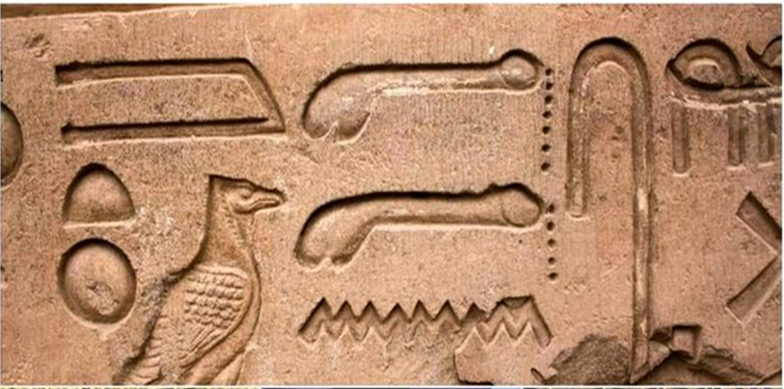We are nothing but dwarves in front of ancient Egyptian civilization

The Romans said it when they came to Egypt: We are nothing but dwarves in front of the ancient Egyptian civilization, that is, a civilization that had a head start in everything.
Ancient Egypt and the sanctification of the penis
The ancient Egyptians were one of the oldest peoples to provide sexual organs, specifically the penis. There are several drawings of Osiris with a large, erect penis, and there are many historical accounts that attribute the beginning of sexual worship to the ancient Egyptians. Many historians mentioned that the Pharaohs were the first people to know this strange worship.
The ancient Egyptians left a good number of murals and statues that illustrate their worship of the ancients, where people appear with giant penises.
Some consider the worship of sexual organs to be one of the strangest types of worship known to humanity. For a person to sanctify a part of his body and dedicate rituals to it is something whose reason is unclear, especially if we look at it in a materialistic way and away from what it may symbolize.
Man has always linked the relationship between a man and a woman, which results in procreation, with the mystery of creation, and viewed it as a cosmic miracle, which prompted some to sanctify or worship the sexual organs, since, in his opinion, they are what give life.
Humanity has known two forms of this type of worship: a form that sanctifies the male organ on the grounds that a man’s water is the basis of creation, and another form that sanctifies the female vagina, and sometimes the breast, since the woman is the one who gives birth and breastfeeds her newborn.

It emphasizes the reverence for the penis.
These monuments show short people with giant penises, such as Bess, the dwarf who had a very long penis. The Pharaohs symbolized the fertility of their country thanks to the waters of the Nile.
The ancient Egyptians also depicted “God Min,” the god of virility and fertility, standing with his penis erect, with two feathers above his head, holding his penis with his left hand and raising his right hand.
A tin and lead sculpture dating back to the Egyptians was found in the Medieval Museum in Paris. It consists of three male penises carrying a female vagina on their shoulders, as in a Pharaonic or Jewish bearing. This sculpture may also prove the Pharaohs’ reverence for the female vagina
"Statues, amulets, and various tools related to sex or in the form of sexual organs among the ancient Egyptians were intended to bring fertility to their owner on Earth or his birth in the afterlife in which they believed."

“Many of the ancient Egyptian gods had their names associated with gender,” he said, enumerating the god “Min” and the god “Amun-ka-mut.if,” which is one of the manifestations of the god “Amun,” the goddess “Hathor,” and the goddess “Isis.” He stressed that “most of those The gods were depicted naked and the males had huge erect penises.”
And the “Turin Papyrus”, which is papyrus No. 5501 in the Museum of Egyptology in the Italian city of Turin, and he considered it the most important sexual document that revealed to us the nature of sex and its place in ancient Egypt. It included a number of brilliantly creative sexual drawings and revealed beliefs in the sexual usefulness of some plants, such as the lotus, which the Pharaohs symbolized for love and sex, and the ivy, which symbolized fertilization. It also included scenes of childbirth on earth and in the other world, “reflecting the greatness of sex in ancient times and the lack of shame.” From him and from showing the sexual organs.”
The "Turin Papyrus", which is papyrus No. 5501 in the Museum of Egyptology in the Italian city of Turin, was considered the most important sexual document that revealed to us the nature of sex and its place in ancient Egypt, as it included a number of brilliantly creative sexual drawings and revealed beliefs in the sexual benefit of some plants, such as the lotus, which is a symbol. It included the Pharaohs' references to love and sex, and the ivy, which symbolized fertility. It also included scenes of birth on earth and in the other world. “Which reflects the greatness of sex in ancient times and not being ashamed of it and showing the sexual organs.”
However, archaeological researcher Ahmed Hammad slightly disagrees with this opinion. And he said
"The ancient Egyptians did not worship any of their organs. The matter was limited to sanctification, not of the organ itself, but of what resulted from the relationship that the organ had. Birth was what the ancient Egyptian man sanctified, not the male organ or the female vagina." He added, "The images circulating from the Pharaonic era show a female vagina carried by males, which is a 'birth chair' and is intended to sanctify the process of creation or the birth of a new life, and not the female sexual organ itself."
The Greeks followed in the footsteps of the ancient Egyptians
The Greeks considered the penis a reason for life, a symbol of production, fertility, and abundance. It appeared in the rituals of Demeter, Hermes, and Dionysus, on walls and sculptures. The matter reached the opening of the "Feast of Dionysia", an Athenian celebration of Dionysus, with huge wooden or metal models of penises carried by men on their shoulders.
They believed that these rituals increased the ability to reproduce. Dionysius, the god of pleasure, happiness, and wine, appeared in his sculptures with an erect, naked member.

On the island of Delos, sculptures in the form of penis models or complete models of the penis and testicles made of white stone were found.
Source: websites

